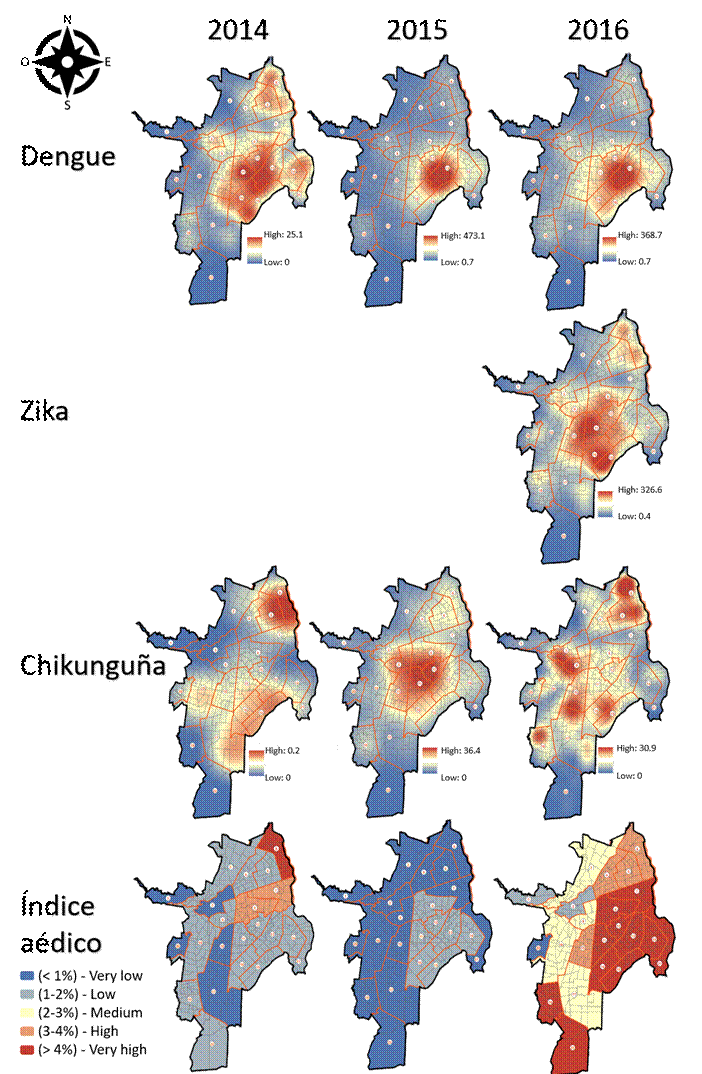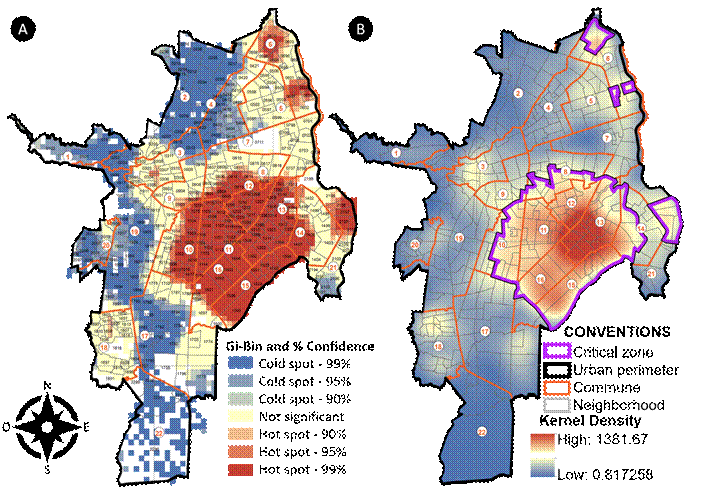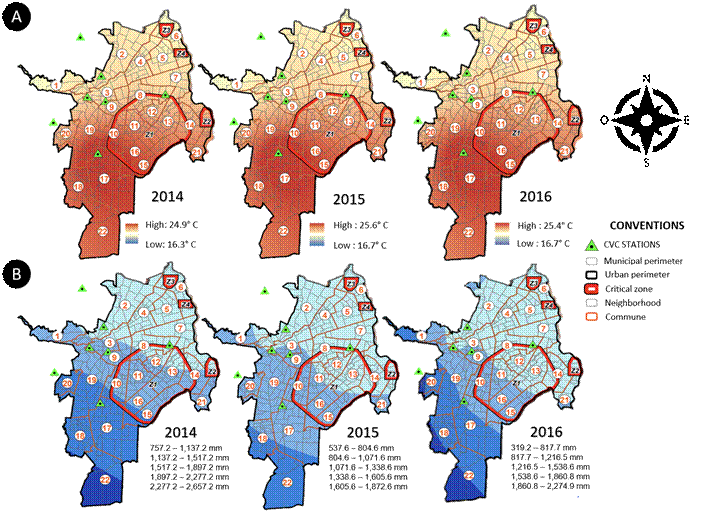Spatio-temporal distribution of Dengue, Zika and Chikungunya in Cali, Colombia: 2014-2016
Distribución espaciotemporal de dengue, Zika y Chikunguña en Cali, Colombia: 2014-2016
Distribuição espaçotemporal de dengue, Zika e Chikungunya em Cali, Colômbia: 2014-2016
Citation: Fuertes-Bucheli JF, Pérez G, Quiroz A, Olaya RA, León-Giraldo H, Pacheco R. Spatio-temporal distribution of Dengue, Zika and Chikungunya in Cali, Colombia: 2014-2016. Univ. Salud. 2024;26(3):A19-A26. DOI: https://doi.org/10.22267/rus.242603.330.
# Abstract
Introduction: Emerging and re-emerging arboviral infections have become a public health challenge in the Americas due to their epidemic potential. Objective: To determine the spatio-temporal distribution of the dengue, Zika, and chikungunya viruses during an epidemic period in Cali, Colombia. Materials and methods: Multi-method descriptive ecological and exploratory study of confirmed and suspected cases reported to the epidemiological surveillance system between 2014 and 2016. Results: 40,168 cases were analyzed, and it was found that dengue was the most frequent arboviral infection (59.2 %). The most affected individuals were women (65 %) and those with a mean age of 34.5 years. Although arboviral infections spread out throughout the city, the three diseases were concentrated in significant groups located at the center-east and northeast areas of Cali (p<0.01; z=-203.7). Conclusions: This study identified critical zones for the three arboviral infections, which are located in areas with low socioeconomic status. Likewise, the results suggest that in addition to eco-epidemiological and bio-psychosocial factors, temperature, precipitation, and the aedic index may play an important role in the spatio-temporal behavior of these diseases. A multidisciplinary and collaborative approach is necessary, which must involve communities and authorities to implement effective control strategies, especially during epidemic periods.
Keywords: Vector borne diseases; arbovirus infections; disease outbreaks; space-time clustering (Source: DeCS, Bireme).
# Resumen
Introducción: Las arbovirosis emergentes y reemergentes representan un reto de salud pública en las Américas, debido a su potencial epidémico. Objetivo: Determinar la distribución espaciotemporal de los virus del dengue, el Zika y el chikunguña, en un periodo epidémico en Cali. Materiales y métodos: Estudio multimétodo descriptivo y ecológico exploratorio de casos confirmados y presuntos notificados al sistema de vigilancia epidemiológica, entre 2014 y 2016. Resultados: Se analizaron 40.168 casos, se encontró que el dengue fue la arbovirosis más frecuente (59,2 %). Los individuos más afectados tenían una edad media de 34,5 años y eran predominantemente mujeres (65 %). Las arbovirosis se distribuyeron en toda la ciudad, pero se identificaron agrupamientos significativos en el centro-este y noreste de Cali para las tres enfermedades (p<0,01; z=-203,7). Conclusión: Este estudio destaca la identificación de zonas críticas para las tres arbovirosis que se localizan en áreas con rezago socioeconómico. Además, los resultados sugieren que factores eco-epidemiológicos y biopsicosociales adicionales a la temperatura, las precipitaciones y el índice aédico pueden desempeñar un papel importante en el comportamiento espaciotemporal de estas enfermedades. Se recomienda una aproximación multidisciplinaria y colaborativa, involucrando a la comunidad y las autoridades, para implementar estrategias de control efectivas, especialmente durante periodos epidémicos.
Palabras clave: Enfermedades transmitidas por vectores; infecciones por arbovirus; brotes de enfermedades; agrupamiento espacio-temporal (Fuente: DeCS, Bireme).
# Resumo
Introdução: Arbovírus emergentes e reemergentes representam um desafio de saúde pública nas Américas, devido ao seu potencial epidêmico. Objetivo: Determinar a distribuição espaço-temporal dos vírus dengue, Zika e chikungunya, em período epidêmico em Cali. Materiais e métodos: Estudo multimetodo, descritivo e ecológico exploratório de casos confirmados e suspeitos notificados ao sistema de vigilância epidemiológica, entre 2014 e 2016. Resultados: foram analisados 40.168 casos, constatou-se que a dengue foi a arbovirose mais frequente (59,2 %). Os indivíduos mais acometidos tinham idade média de 34,5 anos e eram predominantemente mulheres (65 %). Os arbovírus foram distribuídos por toda a cidade, mas foram identificados aglomerados significativos no centro-leste e nordeste de Cali para as três doenças (p<0,01; z=-203,7). Conclusão: Este estudo destaca a identificação de zonas críticas para as três arboviroses que estão localizadas em áreas com atraso socioeconômico. Além disso, os resultados sugerem que fatores eco epidemiológicos e biopsicossociais adicionais à temperatura, à precipitação e ao índice aedico podem desempenhar um papel importante no comportamento espaço-temporal destas doenças. Recomenda-se uma abordagem multidisciplinar e colaborativa, envolvendo a comunidade e as autoridades, para implementar estratégias de controlo eficazes, especialmente durante períodos epidémicos.
Palavras chave: Doenças transmitidas por vetores; infecções por arbovirus; surtos de doenças; conglomerados espaço-temporais. (Fonte: DeCS, Bireme).



